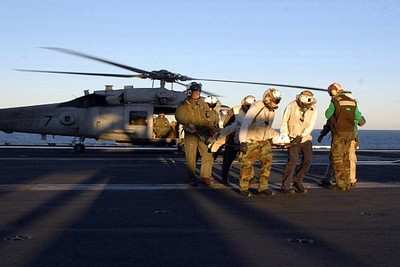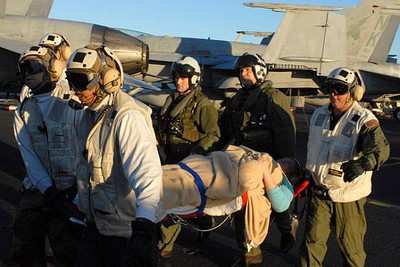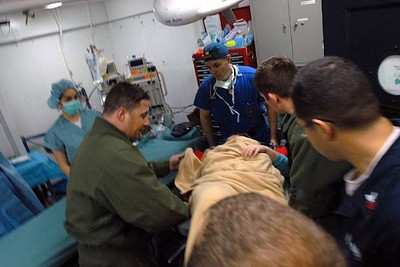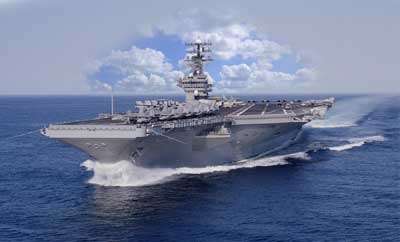CVN 76, HS-4 To The Rescue
Sailors from the USS Ronald Reagan (CVN 76), and the pilots and
aircrew of Helicopter Anti-Submarine Squadron Four (HS-4) rescued a
teenage girl this weekend 15 who suffered a ruptured appendix while
aboard a cruise ship in the Pacific Ocean.

The girl, a 14-year-old from Albion, IL, experienced abdominal
pains while aboard the Dawn Princess. The Bermuda-flagged vessel
was located off the coast of southern Baja California, Mexico and
was approximately 550 miles away from Ronald Reagan when they
issued the distress call late Saturday evening.
"It's a great example of the type of things we are called upon
to do, and it's neat we were able to execute it as well as we did,"
said Capt. Terry B. Kraft, Ronald Reagan's commanding officer.
"I was most impressed with the teamwork on board the ship.
Everybody rallied together," added Kraft. "It was a great
coordinated effort between our helicopter squadron, HS-4, our
medical folks and the Sailors here on the ship that enabled us to
head down there very quickly. I'm also very proud of our ship's
surgeon, who completed a successful operation."
Under the direction of Commander, US Third Fleet and Rear Adm.
Phil Wisecup, Ronald Reagan Strike Group Commander, USS Ronald
Reagan responded to the call for help because it was the closest
vessel with a hospital and the ability to transport and stabilize
the patient.

Ronald Reagan launched two HH-60H helicopters from HS-4 at
approximately 0500 December 15 to transport the patient from the
Princess cruise liner to Ronald Reagan for medical treatment.
Because the cruise ship was unable to provide a landing area for
the helicopter, a basket was lowered in order to raise the patient
into the helicopter for transport.
"The patient was stable upon arrival, however with a presumptive
diagnosis of a ruptured appendix, she was taken straight in to the
operating room," said Cmdr. Theron Toole, Ronald Reagan's senior
medical officer.
Reagan's surgeon, Cmdr. George Linville, performed the emergency
appendectomy. According to Toole, the patient is currently resting
comfortably aboard Ronald Reagan.
"She's getting the best care and her prognosis for a full
recovery is good," said Toole.

Toole said that most cruise ships don't have surgical or
advanced medical capabilities, and are limited to minor emergencies
and some trauma situations.
The HS-4 crew flying the rescue mission was commanded by Lt.
Cmdr. Gregory J. Leland, pilot; Lt. Earl A. Crawford, co-pilot;
Chief Aviation Warfare Systems Operator Matthew Shicks; Hospital
Corpsman 1st Class Scott A. Heintschel and Aviation Warfare Systems
Operator 2nd Class Aaron McCullough-Sanden.
"The motto of the rescue swimmer is, 'So others may live,' and
this mission pretty much embodied that," said McCullough-Sanden.
"It feels really good that tomorrow somebody is going to be OK that
otherwise might not have been."
Ronald Reagan's commanding officer had similar feelings on the
incident.
"This crew is amazing. They always find a way to turn to,
especially when this kind of assistance is needed, for civilians.
As you saw with the San Diego wildfires, or a quick
search-and-rescue-operation like this, they always answer the
call," said Kraft.

Ronald Reagan is currently underway in the Pacific Ocean
conducting tailored ship's training availability. The ship is also
currently operating with other surface assets from the Ronald
Reagan Carrier Strike Group including USS Chancellorsville (CG 62),
USS Howard (DDG 83), USS Gridley (DDG 101) and USS Thach (FFG
43).
Ronald Reagan was commissioned in July 2003, making it the ninth
and newest Nimitz-class, nuclear-powered aircraft carrier. The ship
is named for the 40th USpresident; its motto, "Peace through
Strength," was a recurring theme during the Reagan presidency.
 Aero-News: Quote of the Day (05.20.25)
Aero-News: Quote of the Day (05.20.25) ANN's Daily Aero-Term (05.20.25): Handoff
ANN's Daily Aero-Term (05.20.25): Handoff ANN's Daily Aero-Linx (05.20.25)
ANN's Daily Aero-Linx (05.20.25) Airborne-NextGen 05.20.25: Drone Regs, Zero-Emission Cargo, Door-Dash Drone
Airborne-NextGen 05.20.25: Drone Regs, Zero-Emission Cargo, Door-Dash Drone Airborne 05.19.25: Kolb v Tornados, Philippine Mars, Blackhawk Antler Theft
Airborne 05.19.25: Kolb v Tornados, Philippine Mars, Blackhawk Antler Theft






